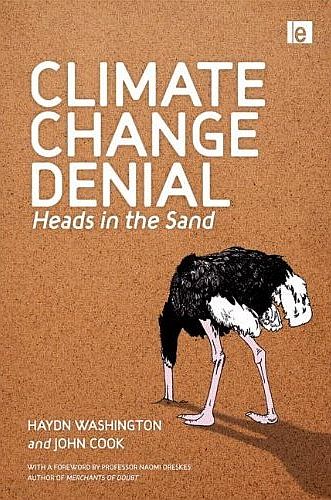

| CLIMATE CHANGE DENIAL: Heads in the Sand Haydn Washington John Cook Naomi Oreskes (Fwd.) London: Earthscan, April 2011 |
Rating: 3.5 High |
|||
| ISBN-13 978-1-84971-336-8 | ||||
| ISBN-10 1-84971-336-7 | 174pp. | SC/GSI | $24.95 | |
The first thing I noticed about this book is that its authors are both scientists. Of course I knew that going in, having read Professor Naomi Oreskes's excellent Foreword. But I mean that I noticed it in the first chapter because the authors write in the style of scientists: they use long, somewhat formal sentences followed by strings of citations. There is also a series of bulleted and numbered lists, reproduced from other sources. The text repeats itself in places, and there is too little white space. I'm sorry to have to say it, but all this makes that first chapter very hard to get through. That's unfortunate, because the subject of the chapter is the nature of denial, and the authors explain it reasonably well.
The second chapter, covering the science of climate change, is much better. The explanations are well done, and seven charts and tables help them along. There are some bulleted lists, but they are not so obtrusive as in Chapter 1. Chapter 3 debunks the main denier arguments, ending with an examination of the claim that the changes will be largely beneficial. A table (pages 59-62) summarizes the effects in agriculture and other areas, demonstrating conclusively that climate change really is a problem.
The remaining chapters discuss the history of denial, what we can do to counter it so that public policies for handling climate change can be enacted, and finally the various measures that offer ways of mitigating, or adapting to, the coming changes in climate.
Each chapter includes a long list of references. An Appendix lists "Greenscam and Denial Groups", although with no descriptions or contact information. (Most of these are drawn from exxonsecrets.org, so that information should be available on-line.) There is a good index. All in all, this is a worthwhile contribution. However, I am giving it a rating of only 3.5, and while I consider it worth reading, I cannot recommend it. Most people, I feel, would put it aside after trying that first chapter. There is nothing wrong with writing in a scientific style, but I tend toward the opinion that a less formal approach would do better for communicating the realities of climate change to the public.

 To contact Chris Winter, send email to this address.
To contact Chris Winter, send email to this address.